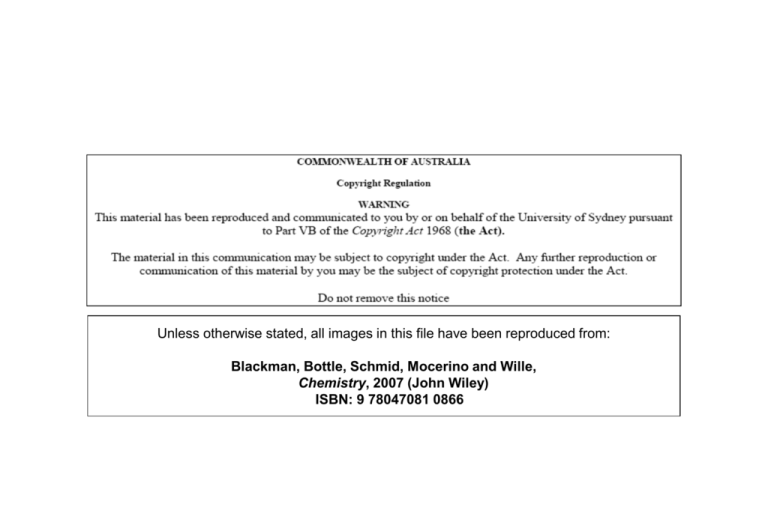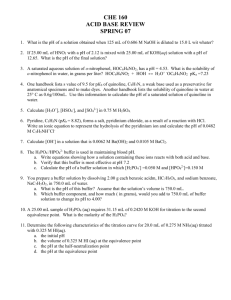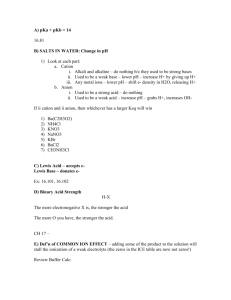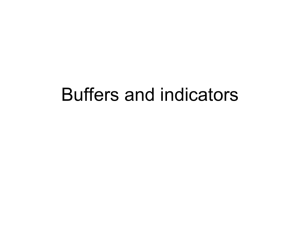pptx
advertisement

Unless otherwise stated, all images in this file have been reproduced from: Blackman, Bottle, Schmid, Mocerino and Wille, Chemistry, 2007 (John Wiley) ISBN: 9 78047081 0866 CHEM1002 [Part 2] A/Prof Adam Bridgeman (Series 1) Dr Feike Dijkstra (Series 2) Weeks 8 – 13 Office Hours: Room: e-mail: e-mail: Monday 2-3, Friday 1-2 543a adam.bridgeman@sydney.edu.au feike.dijkstra@sydney.edu.au e Acids & Bases 3 Lecture 2: • • • Strong/Weak Acids and Bases Calculations Polyprotic Acids Lecture 3: • • • Salts of Acids and Bases Reproduced from ‘The Extraordinary Chemistry Buffer systems of Ordinary Things, C.H. Snyder, Wiley, 2002 Blackman Chapter 11, Sections 11.3-11.6 (Page 245) Slide 3/18 e Salts of Weak Acids and Bases • Is a solution of NaCN acidic or basic? NaCN is the salt of NaOH (strong base) and HCN (weak acid). The base “wins”: pH > 7 Overall reaction is H2O(aq) + CN–(aq) OH–(aq) + HCN(aq) • Does a solution of NH4Cl have pH > 7 or < 7? Salt of NH4OH (weak base) and HCl (strong acid) acid “wins”: pH < 7 and reaction is H2O(aq) + NH4+(aq) NH3(aq) + H3O+(aq) Slide 4/18 e The Common Ion Effect • If you add the salt of an acid to a solution of the same acid then the equilibrium will shift towards neutral. CH3COOH(aq) + H2O(l) CH3COO-(aq) + H3O+(aq) • Addition of CH3COO-: By Le Chatelier’s principle the equilibrium will shift to the left to remove CH3COO- and therefore decrease [H3O+]. • Addition of CH3COOH: By Le Chatelier’s principle the equilibrium will shift to the right to remove CH3COOH and therefore increase [H3O+]. Slide 5/18 e Buffer System Buffer after addition of H3O+ CH3COO- CH3COOH Buffer with equal concentrations of conjugate base and acid H 3 O+ Buffer after addition of OH- OHCH3COO- CH3COOH H2O + CH3COOH H3O+ + CH3COO- CH3COO- CH3COOH CH3COOH + OH- H2O + CH3COO- • A solution containing both a weak acid and its salt withstands pH changes when acid or base (limited amounts) are added. Slide 6/18 e Buffer systems and pH Change • Consider change in pH of pure water (pH = 7) if we add an equal amount of 10–3 M HCl: [H+ ] = 1 x 10–3 M pH goes from 7 to 3! Huge change! What about buffers? Slide 7/18 x Buffer systems and pH Change • Consider a buffer solution with 0.1 M each of sodium acetate (NaAc) & acetic acid (HAc): What is the pH when 10–3 M HCl is added? H+(aq) + Ac–(aq) HAc(aq) Initial: Neutralization (I): Change (C): Equilibrium (E): 0.1 +10-3 0 +x -x 0.1+10-3-x Ka 10 cf slide 6 10-3 0.1 -4.7 x Ka = 10-4.7 0.1 0.1 - 10-3 +x 0.1- 10-3+x x 0.1 - 10-3 x 0.1 10-3 - x Slide 8/18 x Buffer systems and pH Change Ka 10 • -4.7 x 0.1 - 10-3 x 0.1 10 -3 -x x 0.1 - 10-3 0.1 10-3 x = 1.02 Ka = 0.000020 << 0.001 pH = – log x = 4.69 the pH hardly changes from 4.7! Solution is buffered against pH change Slide 9/18 e Henderson - Hasselbalch Equation • For a buffer solution, which contains similar concentrations of a conjugate acid/base pair of a weak acid: [H ][A - ] [H ][initial base] Ka [HA] [initial acid] • The dissociation of HA or protonation of A- does not lead to a significant change in the concentrations of these species. • Taking logs and rearranging gives: [initial base] pH pK a log [initial acid] Slide 10/18 e Buffer Preparation and Capacity • Buffer Preparation If the pH of a required buffer is pKa of available acid then use equimolar amounts of acid and conjugate base If the required pH differs from the pKa then use the Henderson-Hasselbalch equation. • Buffer Capacity Buffer capacity is related to the amount of strong acid or base that can be added without causing significant pH change. Depends on amount of acid & conjugate base in solution: highest when [HA] and [A–] are large. highest when [HA] [A–] Slide 11/18 e Buffer Preparation and Capacity Most effective buffers have acid/base ratio less than 10 and more than 0.1 pH range is ±1 Slide 12/18 e Buffers in Natural Systems • Biological systems, e.g. blood, contain buffers: pH control essential because biochemical reactions are very sensitive to pH. • Human blood is slightly basic, pH 7.39 – 7.45. • In a healthy person, blood pH is never more than 0.2 pH units from its average value. • pH < 7.2, “acidosis”; pH > 7.6, “alkalosis”. • Death occurs if pH < 6.8 or > 7.8. Slide 13/18 e Buffer System in Blood • “Extracellular” buffer (outside cell) H+(aq) + HCO3–(aq) H2CO3(aq) H2CO3(aq) H2O(l) + CO2 (g) Removal of CO2 shifts equilibria to right, reducing [H+], i.e., raising the pH The pH can be reduced by: H2CO3(aq) + OH–(aq) HCO3–(aq) + H2O(l) Slide 14/18 x Example • In the H3PO4 / NaH2PO4 / Na2HPO4 / Na3PO4 system, how could you make up a buffer with a pH of 7.40? DATA: Ka1 = 7.2 x 10-3, Ka2 = 6.3 x 10-8, Ka3 = 4.2 x 10-13 • To make up a buffer, we need pH near pKa pKa1 = 2.14, pKa2 = 7.20, pKa3 = 12.38 must use mixture of H2PO4- and HPO4• Could go through whole procedure... or simply use Henderson-Hasselbalch equation ... Slide 15/18 x Example (Continued) pH pK a2 HPO24 - log H2PO4- original amounts • Require buffer with a pH of 7.40 HPO24 - 7.40 7.20 log H2PO4- HPO24 - 100.20 1.58 H2PO4- the required ratio of Na2HPO4 to NaH2PO4 = 1.58:1 Slide 16/18 x 1 Practice Examples What is the pH of a 0.045 M solution of KOBr? The pKa of HOBr is 8.63. (a) 4.74 2. b) 4.99 c) 8.25 d) 9.01 e) 10.64 A buffered solution is 0.0500 M CH3COOH and 0.0400 M NaCH3CO2. If 0.0100 mol of gaseous HCl is added to 1.00 L of the buffered solution, wahat is the final pH of the solution? For acetic acid, pKa = 4.76 (a) 4.76 (b) 4.46 (c) 4.66 (d) 4.86 (e) 4.54 Slide 17/18 e Summary: Acids & Bases 3 Learning Outcomes - you should now be able to: • • • • • • • Complete the worksheet Understand acid and base equilibria Identify conjugate acid/base pairs Perform calculations with strong acids/bases Use the buffer concept and construct buffers Apply the Henderson-Hasselbalch equation Answer Review Problems 11.36-11.37 and 11.96106 in Blackman Next lecture: • Titrations Slide 18/18







